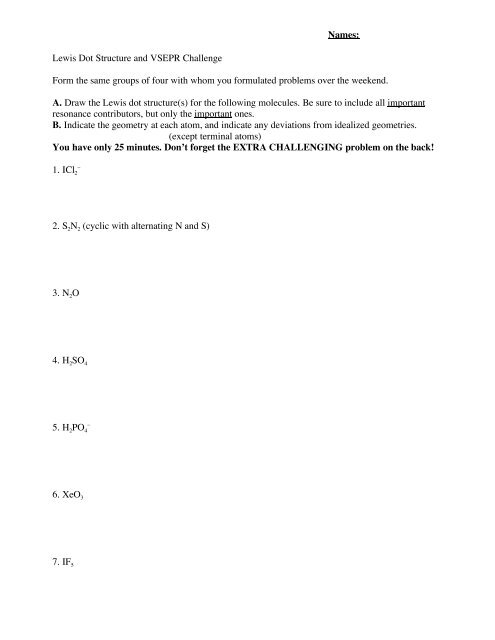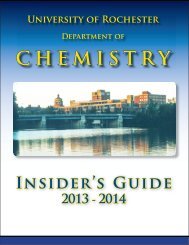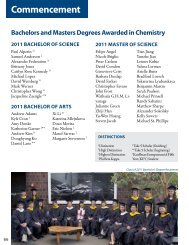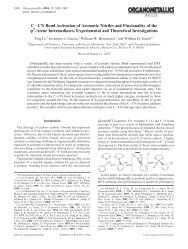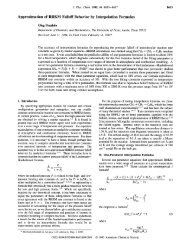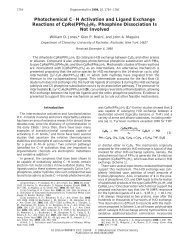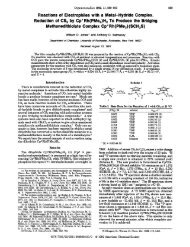Names: Lewis Dot Structure and VSEPR Challenge Form the same ...
Names: Lewis Dot Structure and VSEPR Challenge Form the same ...
Names: Lewis Dot Structure and VSEPR Challenge Form the same ...
Create successful ePaper yourself
Turn your PDF publications into a flip-book with our unique Google optimized e-Paper software.
<strong>Names</strong>:<br />
<strong>Lewis</strong> <strong>Dot</strong> <strong>Structure</strong> <strong>and</strong> <strong>VSEPR</strong> <strong>Challenge</strong><br />
<strong>Form</strong> <strong>the</strong> <strong>same</strong> groups of four with whom you formulated problems over <strong>the</strong> weekend.<br />
A. Draw <strong>the</strong> <strong>Lewis</strong> dot structure(s) for <strong>the</strong> following molecules. Be sure to include all important<br />
resonance contributors, but only <strong>the</strong> important ones.<br />
B. Indicate <strong>the</strong> geometry at each atom, <strong>and</strong> indicate any deviations from idealized geometries.<br />
(except terminal atoms)<br />
You have only 25 minutes. Don’t forget <strong>the</strong> EXTRA CHALLENGING problem on <strong>the</strong> back!<br />
1. ICl 2<br />
–<br />
2. S 2 N 2 (cyclic with alternating N <strong>and</strong> S)<br />
3. N 2 O<br />
4. H 2 SO 4<br />
5. H 2 PO 4<br />
–<br />
6. XeO 3<br />
7. IF 5
<strong>Names</strong>:<br />
8. What elements could correspond to X, Y, <strong>and</strong> Z in <strong>the</strong> following <strong>Lewis</strong> dot structure?<br />
Z<br />
Z<br />
X<br />
Z<br />
Y<br />
Z<br />
Z Z<br />
Here is a reminder of <strong>the</strong> procedure for determining <strong>Lewis</strong> structures.<br />
(a) Draw <strong>the</strong> ion/molecule without any bonds. The central atom is usually <strong>the</strong> least<br />
electronegative atom.<br />
(b) Count <strong>the</strong> number of valence electrons in <strong>the</strong> whole ion/molecule. For ions, don’t forget to<br />
include charges!<br />
(c) Insert <strong>the</strong>se electrons, using lines to represent shared pairs of electrons. Attempt to fulfill <strong>the</strong><br />
octet rule; for atoms beyond <strong>the</strong> 2 nd period, you may go over 8 if necessary.<br />
(d) Assign formal charges to each atom: charge = (# valence electrons in free atom) – (# lone<br />
pair electrons on <strong>the</strong> atom in <strong>Lewis</strong> structure) – (# bonds to <strong>the</strong> atom).<br />
(e) Brainstorm. Repeat steps (c) <strong>and</strong> (d) until you have found all reasonable <strong>Lewis</strong> structures.<br />
(f) Double-check. Your <strong>Lewis</strong> structures should have <strong>the</strong> <strong>same</strong> number of groups around <strong>the</strong><br />
central atom, <strong>same</strong> number of electrons, <strong>and</strong> <strong>same</strong> total charge. If so, <strong>the</strong>y can be valid<br />
resonance structures.<br />
(g) Prioritize your <strong>Lewis</strong> structures based on <strong>the</strong> following criteria, in order of decreasing<br />
importance: octets, maximum number of bonds, separation of formal charge, formal charge<br />
on atom with appropriate electronegativity.<br />
(h) Create a “resonance” description of <strong>the</strong> ion/molecule with double-headed arrows connecting<br />
<strong>Lewis</strong> structures.<br />
(i) Work out <strong>the</strong> geometries of <strong>the</strong> ions/molecules using <strong>VSEPR</strong> rules from class. Discuss any<br />
deviations from ideal geometry.


